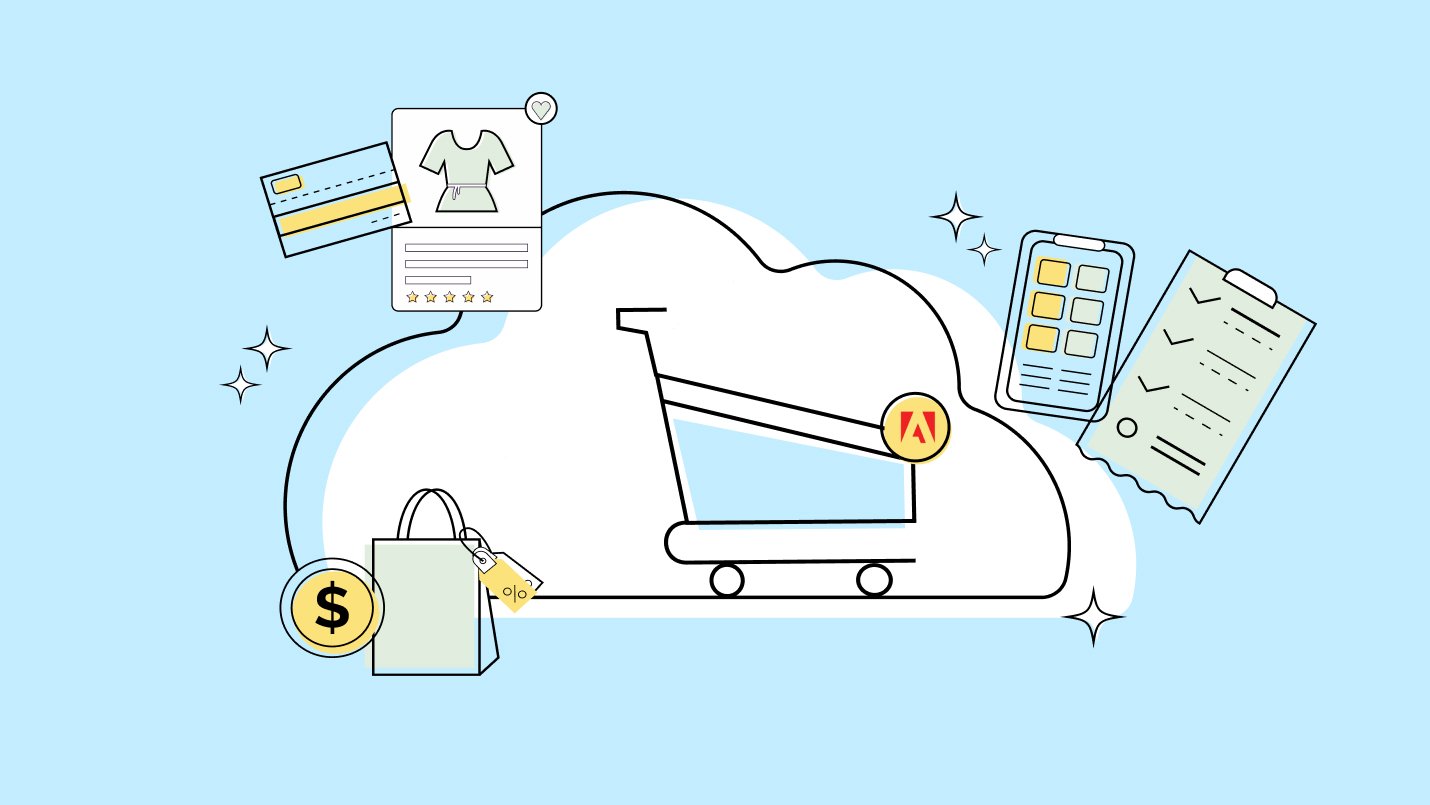Cloud eCommerce leverages the power of cloud computing and modern digital commerce platforms to help store owners sell goods and services online.
If you are a small or medium-sized business looking to compete in the online commerce marketplace, we’ll break down all the ins and outs of how to select the right cloud eCommerce platform, including:
- A deeper understanding of cloud eCommerce and what it can do
- Different eCommerce hosting and architecture models
- The benefits of cloud eCommerce platforms to improve growth and operational efficiency
- How to choose the best eCommerce platform
- Future trends in cloud eCommerce
What is Cloud eCommerce?
What is eCommerce? An eCommerce platform or digital commerce platform is software that operates your online store, a specialty type of content management software (CMS) designed for commerce data and processes of selling products or services to customers (B2C) or other businesses (Learn more about B2B eCommerce platforms), as well as other emerging eCommerce business models.
eCommerce platforms can be free and self-hosted by you in the cloud (called open-source and/or on-premise) or licensed and available bundled with infrastructure and commerce services (PaaS or SaaS, see Cloud-Based Service Models).
At one time, many eCommerce websites were operated on-premise, run on servers located in a businesses physical office. Today, much of that is shifting to the cloud—third-party remote servers that host software or infrastructure accessed over the Internet. Cloud eCommerce is the use of different levels of cloud services to make it easier to run an online store.
Cloud eCommerce Architecture
There are three primary kinds of architecture that support cloud eCommerce: traditional, headless and composable. Let’s review these individually.
Traditional vs Headless vs Composable Architecture
Cloud eCommerce software includes two main parts: a way for users to access the store (the front-end) and the systems that power those experiences (the back-end). How the front-end and back-end are linked together is the differentiating feature between traditional, headless and composable. While this is an architectural distinction, the difference directly influences how easy it is to interact with the platform and how much it can be customized.
Traditional eCommerce
When the front and back-ends of an eCommerce application are tightly coupled as an all-in-one application, we call this a “traditional” eCommerce platform. A traditional platform will use one front-end template to define how your store looks and operates, so it’s easy to set up and use.
Headless commerce
In a headless commerce platform, the front and back are decoupled (separated) and communicate by API, so you can create multiple front-ends for each channel or device, helping support omnichannel retailing. (Learn more about headless CMS vs traditional CMS and eCommerce APIs).
Composable commerce
In a composable commerce platform, each element of the system can be decoupled, so instead of one back-end application, we instead use microservices organized around “packaged business capabilities” or PBCs for critical functions (e.g. reviews, loyalty, service, payments) to optimize performance, customizability and agility. Composable commerce often leverages MACH architecture (M – Microservices, A – API-First, C – Cloud-Native, H – Headless).
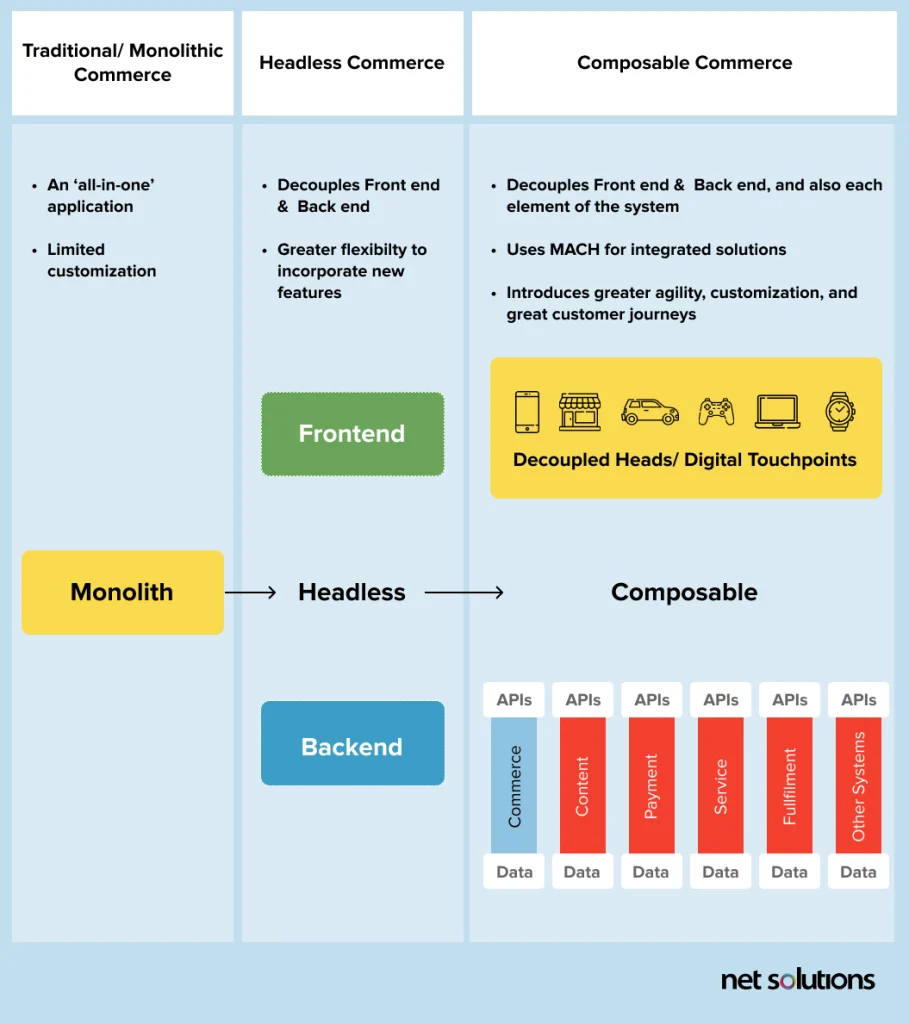
Now, let’s break down some of these components to talk about how they impact cloud eCommerce.
How Does Cloud eCommerce Work?
There are several components to cloud eCommerce that we need to consider.
1. Infrastructure
As noted above, cloud infrastructure represents all of the servers, storage resources and networking components that eCommerce is built upon. Infrastructure providers or “cloud service providers” (CSPs) include Amazon Web Services (AWS), Microsoft Azure, Google Cloud, IBM Cloud and more.
These CSPs “rent” their cloud technology services either directly to you (infrastructure-as-a-service or IaaS) or bundled with your eCommerce platform, allowing you pay-as-you-go access to scalable resources without having to invest in the hardware yourself.
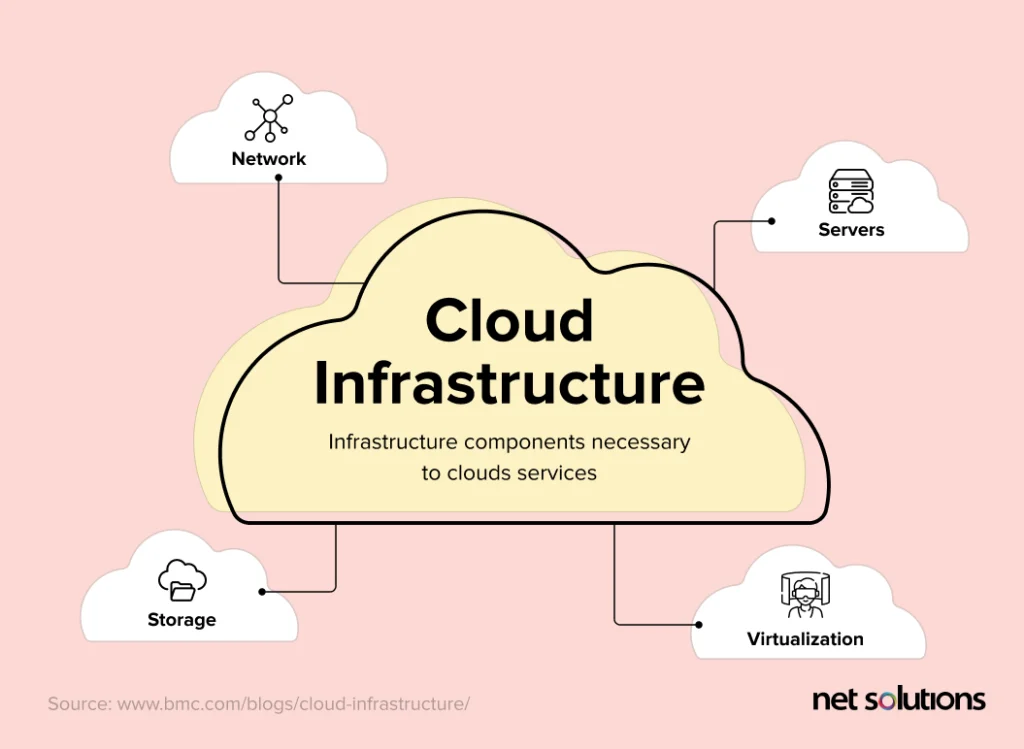
There are different cloud service models that differentiate based on the scope of service provided.
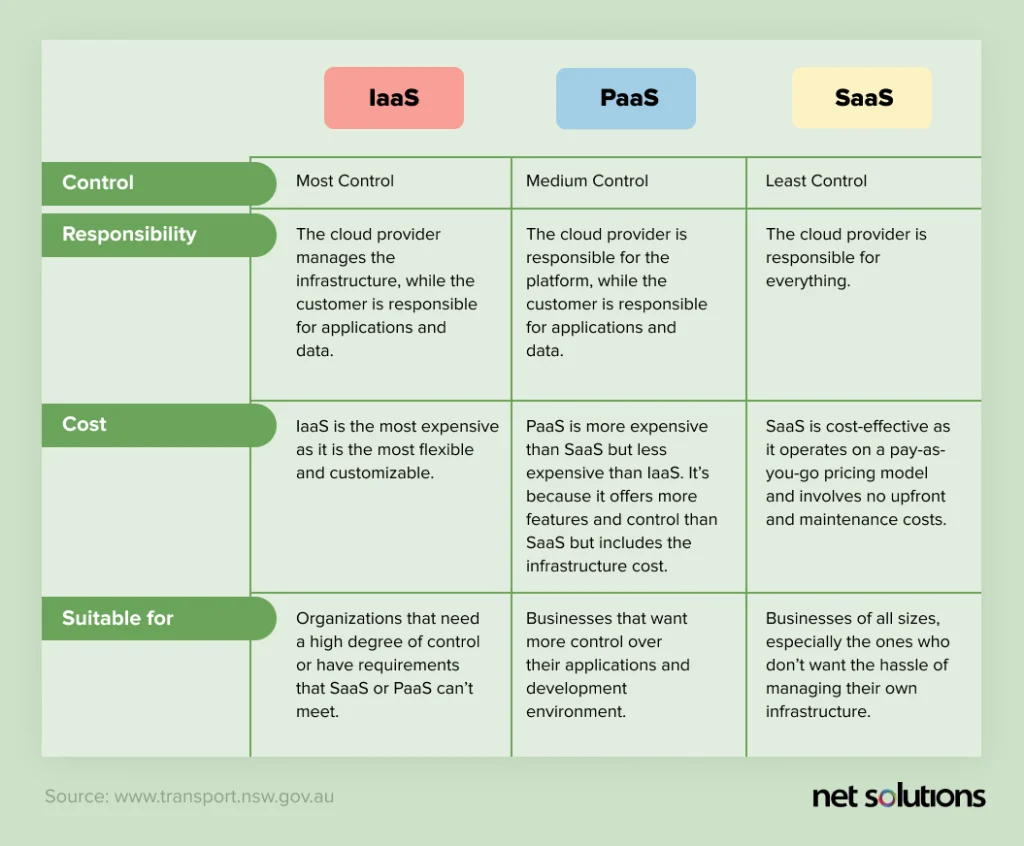
Learn more: IaaS vs PaaS vs SaaS: Which Cloud Strategy is Right for Your Business?
2. IaaS eCommerce
Infrastructure-as-a-service (IaaS) refers to purchasing on-demand cloud infrastructure to host your eCommerce platform from CSPs such as Amazon AWS. With IaaS, you would be responsible for provisioning and managing your eCommerce platform. An example would be Magento Open Source hosted on AWS.
If you pursue this route, we encourage you to read more about critical AWS Services for eCommerce.
3. PaaS eCommerce solution
Platform-as-a-Service model provides infrastructure (e.g. servers and OS) to set up an eCommerce site, with the client building and configuring the content, application code and products. Headless eCommerce solutions are often PaaS. Some PaaS eCommerce platforms such as Adobe Commerce can include pre-integrated services, making them more like a SaaS offering.
4. SaaS eCommerce solution
A software-as-a-Service (SaaS) eCommerce platform is ready-to-use commerce software that can be accessed via the Internet. SaaS eCommerce platforms include all back-office capabilities to manage an online store and are hosted and managed by the vendor and available via subscription (pay-as-you-go). A SaaS eCommerce platform is the easiest to use, but the least customizable / controllable, though some of this is overcome by choosing headless or composable commerce solutions.
5. Integration with third-party services
Regardless of architecture and cloud service model, eCommerce platforms are specifically designed to be a “base” set of capabilities that can be expanded by integrating with third-party services (apps, plugins, integrations) across a variety of capabilities including merchandising, marketing, payment gateways and services, product sourcing, checkout, analytics, customer service and more.
Now let’s examine some of the benefits of cloud eCommerce platforms.
Benefits of Cloud eCommerce Platforms
The benefits of cloud eCommerce depend on the number of cloud services that are bundled into the solution. Generally speaking, the greater the cloud services, the greater the following benefits:
1. Scalability
In general, one of the main benefits of the cloud is that it offers more scalable infrastructure to meet demand. However, as mentioned earlier, the eCommerce architecture format (traditional, headless, compostable), impacts how the eCommerce application scales and performs in response to traffic and demand. More decoupled, microservices-based infrastructure allows each element to scale independently, helping optimize and balance performance.
2. Flexibility and agility
Different cloud models and architectures allow for different levels of flexibility and agility to respond to changing business opportunities or demands: to add capacity, change servers, add new features, add or alter third-party services.
3. Continuous updates and maintenance
One of the benefits of cloud services is offloading some of the maintenance and updates associated with those services. Depending on the level of cloud services (infrastructure, platform, and/or software), you can expect regular patches and updates to support performance, security or improved features. When utilizing a cloud-based eCommerce platform (SaaS, PaaS), you can expect regular updates and new features to be integrated seamlessly, easing IT administration.
4. Accessibility
With a cloud eCommerce set-up, providing store owners and IT admins the ability to access the platform from any location. Not only is this great for distributed or global organizations, but it helps support small eCommerce businesses and remote contractors.
5. Cost-efficiency
All cloud models help you save money on IT infrastructure costs, including hardware purchase and maintenance and inevitable replacement costs, as well as custom software to run an online store. Although different cloud models will come with different costs, in terms of bundled services, these specialized services far outstrip the capabilities that can be created in-house, particularly when we consider the benefits of agility.
6. Security and compliance
Although a reduction in control used to be one of the “cons” associated with the cloud, the truth is that cloud service providers (CSPs) have significantly more resources to devote to security than the standard organization. Most infrastructure providers will attest to strong security practices and privacy requirements, including PCI DSS, ISO or GDPR. Cloud infrastructure is designed to meet the highest security requirements, with advanced capabilities for governments, financial institutions and highly sensitive information. AWS, for example, supports 143 security standards and compliance certifications.
Cloud providers and eCommerce platform vendors ususally provide security services and features to help enhance how store owners manage security and compliance. Additionally, cloud services have the benefit of redundancy for back-ups, helping with disaster recovery. Regardless of the cloud service model, cloud security and compliance are ultimately a shared responsibility, with the onus on the store to adopt strong security measures (e.g. access controls and strong multi-factor authentication).
7. Performance and reliability
Most cloud service providers rely on high performance of CSPs such as Amazon AWS, which provides a global network of infrastructure to help support high availability across the world. Look for service level agreement and uptime indicators, but you’ll see that most cloud services list anywhere from 99-99.99% availability, which offers minimal downtime.
Now let’s examine some key features of cloud eCommerce platforms.
Key Features of of Cloud eCommerce Platforms
All cloud eCommerce platforms are content management systems that help create and manage digital content. Let’s explore some of the other features:
1. Data storage
eCommerce applications store a great deal of information including product information, customer data, transaction records. The cloud offers the benefit of scalability and simplified business operations, with many cloud services bundling security, disaster recovery and back-up capabilities with data storage.
2. Analytics
Since data may come from many different sources and many eCommerce solutions are designed to help pull in data sources into a single unified view and provide analytics to derive business intelligence from data to support decision making.
3. Price Tiers
Most eCommerce platforms utilize price tiers to offer flexible plans to a wide range of businesses. Most platforms leverage a “size” metric to differentiate between price tiers, whether this is based upon gross merchandise value, sales revenue, or number of orders. Most price tiers also have limits of some sort such as number of API calls, number of roles or locales, with the ability to bump these up in contract or to move to the next tier.
4. Marketing & SEO
Platforms have differing capabilities to support some marketing capabilities (e.g. email marketing, blog), but all help you create a marketable online store. Look for platforms with built-in capabilities to support strong search engine optimization (SEO) such as image alt tags, customizable and canonical URLs, sitemaps, strong site speed, and mobile-optimized content.
5. Search
Search for an eCommerce platform is more complex, as you could pull up too many results for “t-shirt” on a retail website. The search capabilities should include added features for photos, filtering, and possibly even personalization to reduce friction in the buying experience.
6. Product or Catalog Management
The product management component is how you upload and manage products or services listed on the store. Look for features on a B2C platform such as bulk uploads, categorization, and filtering. For a B2B platform, you will want advanced catalog capabilities, as personalized catalogs are key for most B2B sales scenarios.
7. Shopping Carts & Payments
All eCommerce platforms will have features to assist in pricing, shopping carts and payments. These flows will differ for B2C vs B2B websites, but in general this ability to ‘buy’ is what sets an eCommerce solution apart from a regular website. For a B2B, this can include quoting, invoicing or alternative payment capabilities. Payments are assisted by third-parties in most cases, as ‘payment gateways’ such as PayPal or Stripe.
8. Inventory Management
Tracking stock levels and the movement of goods through the supply chain is critical to meeting demand. As you expand to new channels (e.g. social media, marketplaces), it is critical to ensure that inventory is synced between channels and that you have solutions in place to assist (vs. manually tracking). Where platforms don’t offer robust capabilities, this can often be supported by third-party integrations as well.
9. Order Management
The backend processing of the shopping experience is order management, consolidating orders from one channel (the website) or many channels (e.g. different countries or channels) with one centralized backend to streamline how you manage and fulfill orders. Where relevant for B2B, seek out platforms that support bulk ordering or re-orders.
10. Shipping & Fulfillment
Ideally linked with inventory management, physically getting the product from wherever it is stored out to the customer can be a complex process involving receipt of goods from a supplier, storage, packing, shipping, tracking, and processing returns. While you often have to leverage a third-party solution for this (e.g. ShipStation), your integration should display and oversee this within the platform.
11. Multi-Store Capabilities
Multi-store eCommerce is the ability to launch more than one web store and to manage that from one platform. The separate “stores” could be new locations (languages and/or locales), new brands, or even B2B vs B2C capabilities. Not all platforms offer this capability.
Now let’s explore the benefits or running an eCommerce store in the cloud:
Transitioning to a Cloud eCommerce Solution
If you’re starting a new online store or are migrating from an on-premise eCommerce solution to a cloud eCommerce solution (a process known as application modernization), the process involves careful planning.
1. Selecting the right cloud eCommerce platform
There are many kinds of eCommerce platforms in the market, from open-source solutions to all-in-one SaaS to more advanced and customizable solutions. If you don’t know where to start, we encourage you to read:
- 12 Essential Factors for Choosing the Best eCommerce Platform
- How to Choose the Right B2B eCommerce Platform
We’ve also listed some of what we consider the best cloud eCommerce platforms in the next section.
2. Migration planning
If you already have an online store and you’re struggling with scalability, cost or complexities of one part or another, you’ll be replatforming to a new e-commerce services solution. This involves:
- Articulating clear business goals and business needs
- Creating requirements for technology and design
- Preparing for data migration (mapping and cleaning data)
- Using built-in or third-party tools to carefully migrate data, ideally supported by an experienced partner
(Learn more: what is replatforming?)
3. Post-migration support and troubleshooting
Develop a plan to validate the results of the migration, ensuring all customer data, product data and order data is moving over as expected. Test for accuracy of pricing, online search, links, features, and the checkout process. Continue this as new features and integrations are rolled out.
4. Implementing security measures
Support your cloud eCommerce deployment by knowing your responsibilities under any shared responsibility agreement. Explore the security tools available, setting up strong authentication and access controls for admin users as well as for customer accounts. Depending on the cloud model, your responsibility can include backup and restore capabilities, testing, firewall, encryption or other measures.
5. Integrating third-party apps
Enhance your eCommerce platform by integrating with third-party services such as payment gateways or fulfillment services. Always defer to those services that are vetted and listed in your eCommerce platform marketplace. Ensure all integrations are tested.
The Best Cloud eCommerce Platforms
We’ve created this list of cloud-based eCommerce platforms that offer comprehensive and scalable capabilities to support an eCommerce business:
1. BigCommerce
BigCommerce is a SaaS headless and composable eCommerce platform that offers full enterprise capabilities, ideal for medium-to-large stores. BigCommerce can be used headless or with friendly low code no code tools for storefront design, supports multi-storefront capabilities, and has a B2B edition. Pricing starts as low as $29/month. Learn more about Going Headless with BigCommerce.
2. Shopify
Shopify represents a 17.73% market share of all eCommerce platforms, offering strong site performance and checkout experiences, new AR and 3D capabilities and a robust app store. Shopify plans start at $29/month.
3. Adobe Commerce (Magento)
Adobe Commerce (previously Magento) is an all-in-one eCommerce PaaS solution with pre-integrated composable commerce (SaaS) services, leveraging native AI capabilities, multi-storefront, advanced personalization and a B2B edition. Adobe Commerce is available only at custom pricing ($$$) or can be used open-source as Magento Open Source. Learn more in our Ultimate Guide to Adobe Commerce.
4. commercetools
commercetools is a composable commerce solution that can be used with pre-integrated capabilities for frontend, checkout and other experiences, with support for B2B, B2C and D2C from a single platform. commercetools plans start at $29/month.
5. VTEX
VTEX is a composable commerce platform that supports B2C, B2B, marketplace and omnichannel operations, allowing the ability to only uncouple the capabilities that you want to extend your business capabilities. Prices are not transparent, but likely start around $500/month.
6. SCAYLE
SCAYLE (SCAYLE Commerce Engine) is an enterprise B2C composable commerce platform that includes comprehensive commerce features to manage customer experiences, stores, markets or brands (even without code) and the option to use a built-in storefront. Pricing starts around $5000/month.
7. Salesforce Commerce Cloud
Salesforce Commerce Cloud is a unified commerce solution designed for enterprises, leveraging strong AI predictive intelligence, with editions for B2C, B2B and D2C, and deep integration within the Salesforce Customer Success Platform. Pricing begins at 1% gross merchandise value.
In choosing your eCommerce platform, keep in mind not only what you need for today, but also what you’ll need in the future. For that, let’s examine some eCommerce trends.
The Future of Cloud eCommerce
Across all sectors, buying is increasingly shifting to the cloud, expected to represent 22.6% of all sales by 2027. When evaluating eCommerce platforms, be aware of some of the eCommerce trends that are shaping the future of eCommerce systems:
1. AI and GenAI
Many of the top eCommerce platforms have already started offering artificial intelligence and machine learning. Although AI is shaping all aspects of retail, AI (particularly generative AI or GenAI) is helping with:
- Personalized shopping (search results, product recommendations) based on browsing, location or purchase history
- Personalized offers based on browsing
- AI chatbots and customer service
- A/B campaign testing
- Inventory management
- Workflow automation for developers and content creators (SEO tagging, blog posts, product pages, image optimization)
2. Conversational commerce
Conversational commerce is the increased use of chat to engage with customers during their shopping experiences. Whether integrated into the core eCommerce platform or through third-party services such as Gorgias, AI-powered customer interactions can be used for customer support and livechat or onsite marketing campaigns.
3. Personalized shopping
Today, 69% of business leaders are investing in personalization, making this a must-have feature across all websites – and increasingly important to convert sales and boost retention rates. Further, over half of customers are more likely to make a repeat purchase when their experiences have been personalized.
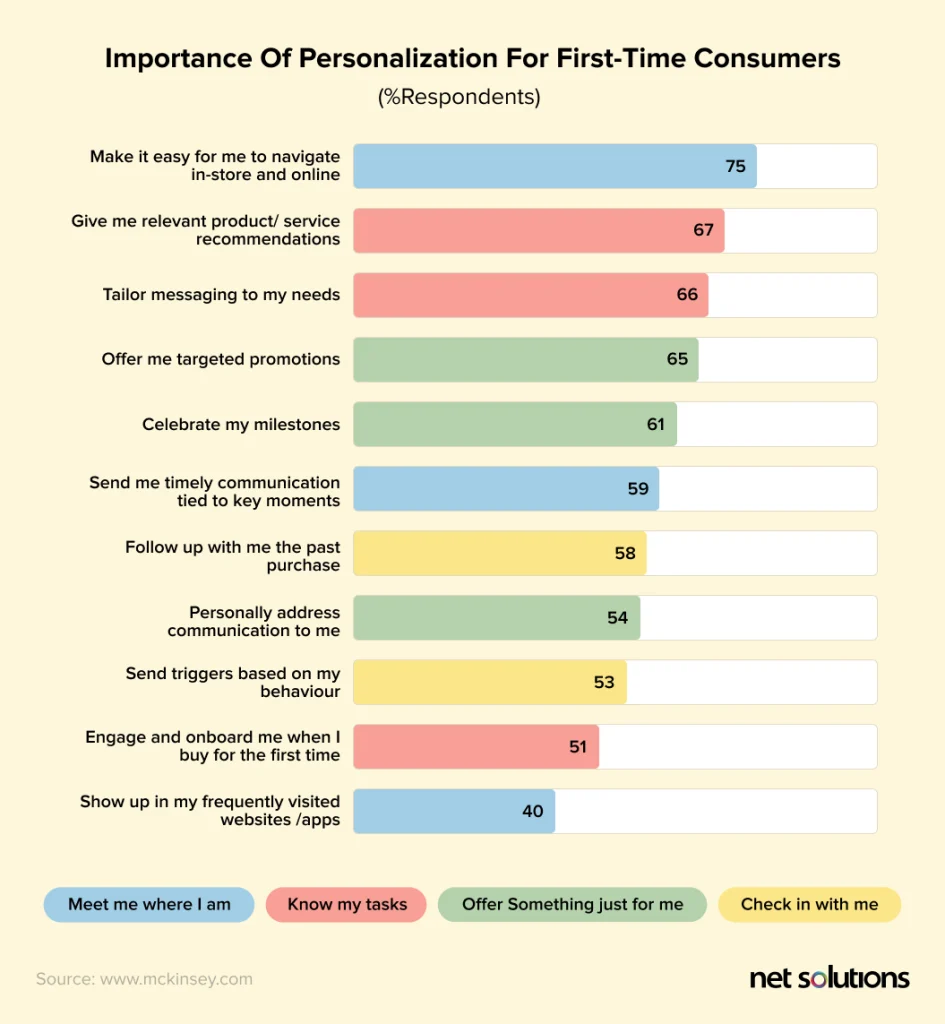
4. AR & VR
Augmented reality and virtual reality (AR and VR) are increasingly being integrated into shopping experiences, to see how furniture will look or to try on clothes, glasses or makeup.
5. Omnichannel and social commerce
Today, an increasing number of shoppers are looking for or completing their purchases on a mobile device, or are switching between devices and channels during their buying experience (e.g. from a social media channel to a website). Creating an omnichannel strategy is about ensuring that customers can move seamlessly between channels and that information across all channels (e.g. inventory, shopping carts, location-based recommendations) is synced and optimized.
6. Voice commerce
Voice commerce, or voice-activated shopping, uses voice recognition technology such as Amazon Echo, Google Home or Siri (HomePod or device) to search for products and make purchases with voice commands. Voice commerce can offer both convenience as well as accessibility, allowing for a hands-free shopping experience.
Today, many shoppers use voice assistants to add items to a shopping list – voice commerce takes that one step further and helps complete the purchase.
Need More Information About Adopting Cloud eCommerce?
Cloud eCommerce solutions are a cost effective, agile way to launch and scale your online business. There are many decisions you need to make, from choosing the right architecture and eCommerce platform to all the tools and services to support your store.
At Net Solutions, we provide outsourced eCommerce development including consultation, development, migration and design services to help you stay one step ahead of today’s rapidly changing marketplace.

